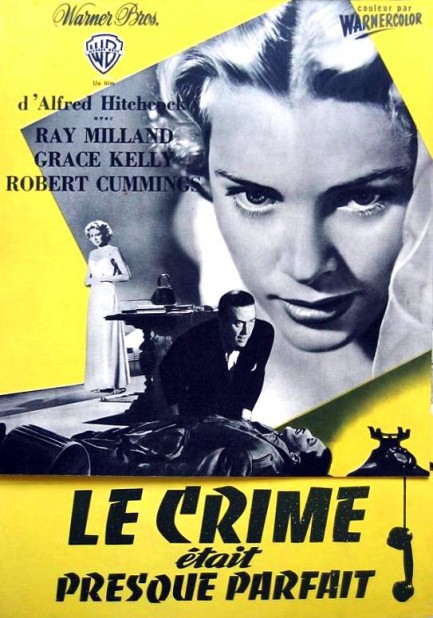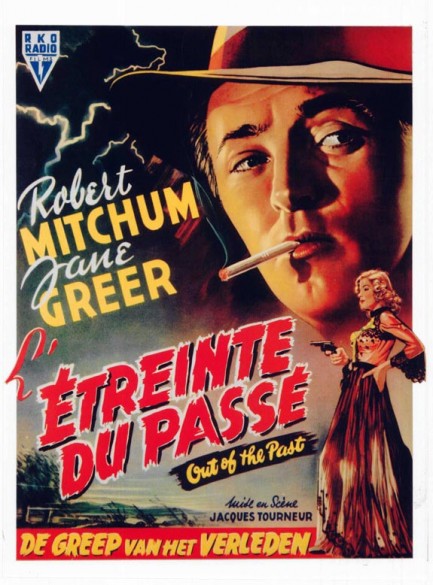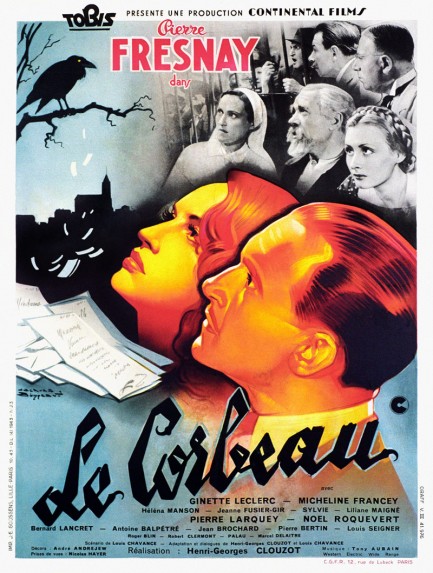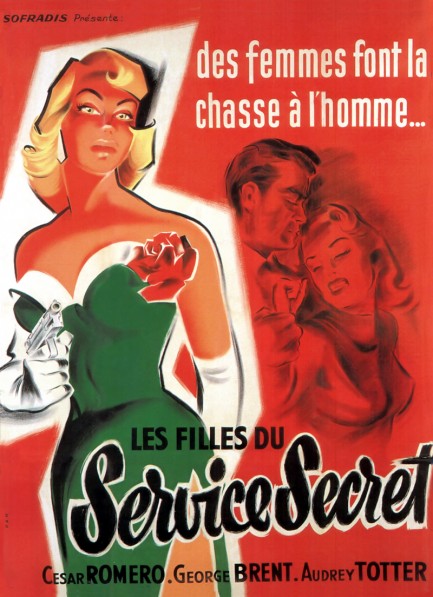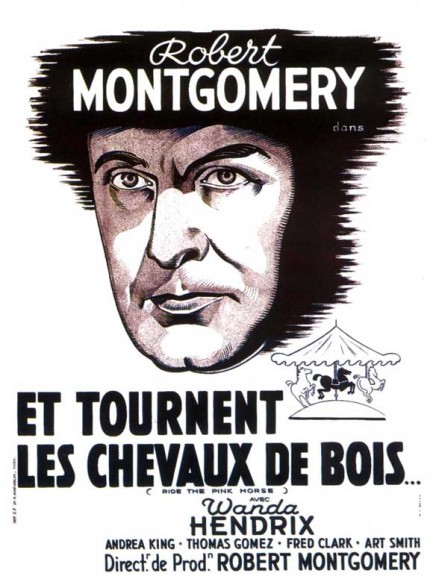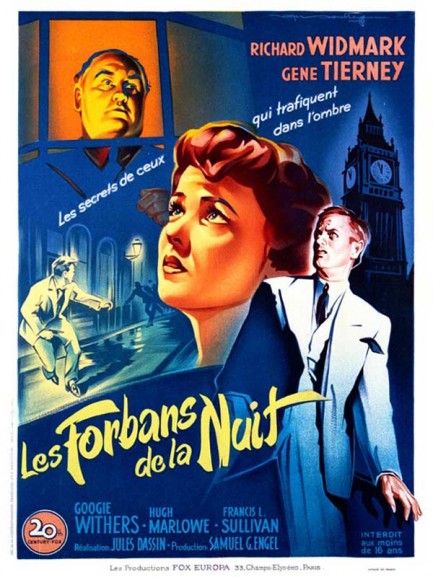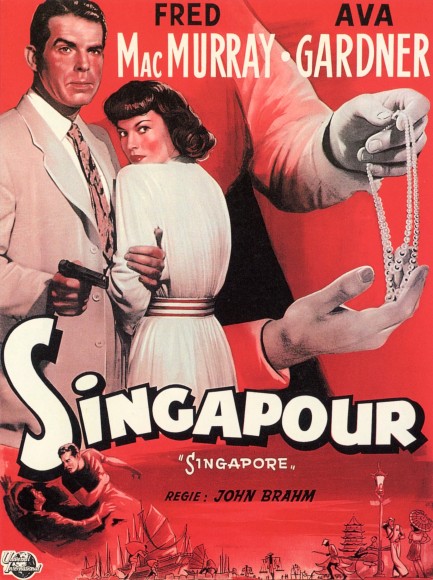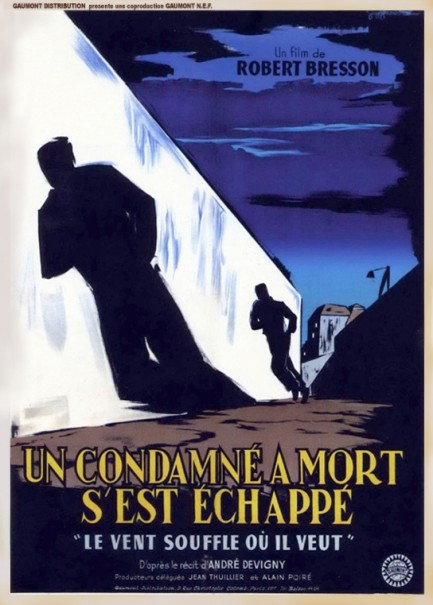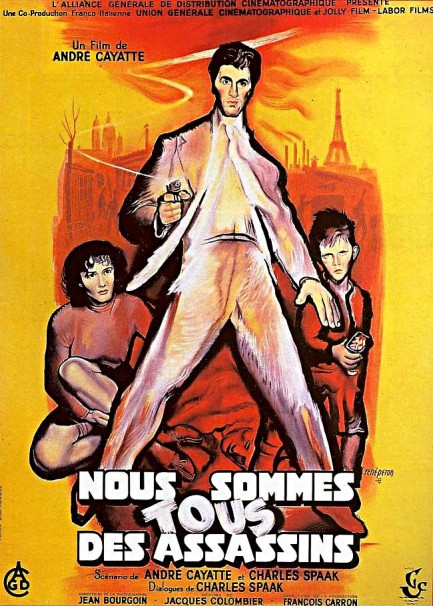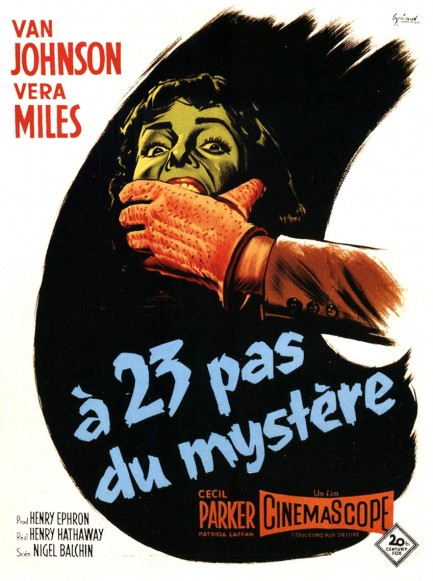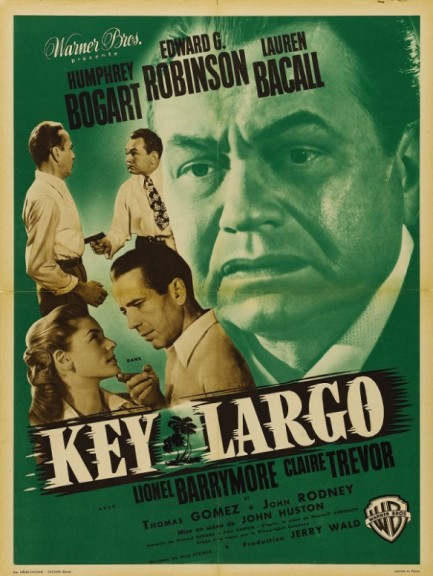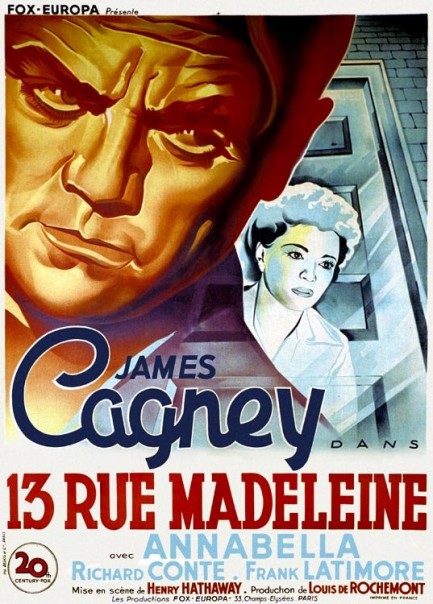 This Sorcerer performs some scary tricks. 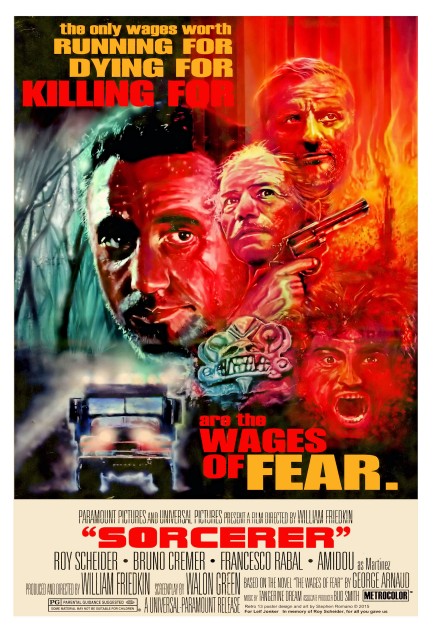
The dark action drama Sorcerer, for which you see a promo poster above, is one of those movies that didn't do well when it was released, but has been reevaluated a bit in recent years. We watched it last night and came away impressed. One of the main criticisms of this movie was that it was too long and too focused on backstory, but in this new era of streamed entertainment, considerations such as running times have gone out the window. You've noticed that, right? How much longer movies have gotten now that they're consumed in the home? Netflix and the other streaming services apparently figure you aren't going to watch the film without stopping it several times anyway, so why fret about their length. And certainly this is one of the enticements for modern directors working with streaming services. No butchery by studios obsessed with running time. Less interference. In such a milieu, Sorcerer isn't overly long, or overly detailed. Some of its weaknesses have become strengths.
The story is actually pretty simple, despite all the hand-wringing over its length and structure. Four shady crooks in a Latin American town called La Piedra are chosen to drive two trucks of nitroglycerine days through treacherous jungle so the explosives can be used to extinguish a raging oil well fire. The oil company is desperate, and so are the men. Though the explosives are cushioned in beds of sawdust, one serious bump and these guys will be raining down in pieces. They're four hard luck men stuck in a hellhole, and even though the trip has low survivability, they'll do anything for a chance at a new start in life. But the characters' Conradian journey from La Piedra into pure madness comes later. The movie first tells how each man came to be in circumstances where getting out of town is worth risking their lives. Each of their stories is bizarre and violent. We suspect this bothered viewers. It makes the teaming up of the group seem unrealistically coincidental, but it's a simple structural artifice. There's no coincidence. Any four men chosen to drive the trucks would have crazy histories.
Sorcerer also tells in detail how that oil well became an inferno, again throwing viewers. They probably asked why such details were needed. But they are needed. The movie is based on Georges Arnaud's novel Le salaire de la peur, aka The Wages of Fear, a capitalist 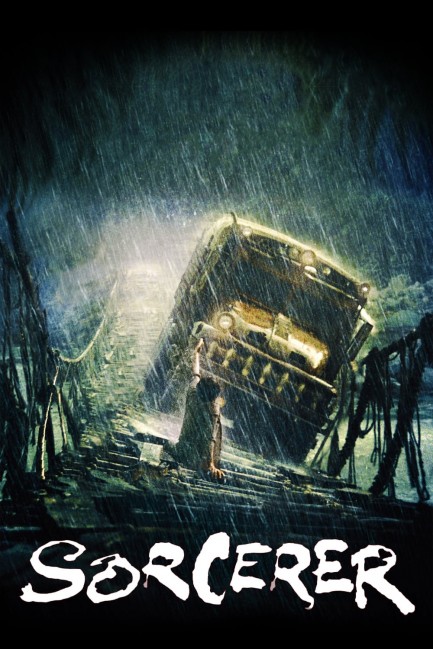 critique about how the impoverished will take deadly chances for a little cash, and how corporations take advantage of that desperation without concern or empathy, particularly when the balance sheet slips into the red. The backstory of the oil company is important to the narrative. critique about how the impoverished will take deadly chances for a little cash, and how corporations take advantage of that desperation without concern or empathy, particularly when the balance sheet slips into the red. The backstory of the oil company is important to the narrative.
Yet another reason the movie was poorly received is the title. Director William Friedkin had previously scored a global hit with The Exorcist. A title like Sorcerer sounds supernatural, but it's actually the name of one of the trucks the characters drive. Universal Pictures and Paramount Pictures, which both backed the film, didn't do much to counter mistaken impressions. They thought they had a dud on their hands so they promoted the movie in a way that made it seem eerie to take advantage of Friedkin's reputation. Many filmgoers walked away feeling cheated, and many reviewers too, we suspect. If the internet had existed back then maybe filmgoers would have known Sorcerer was based on a novel, as well as on a French adaptation from 1953.
But setting all that aside, this much is true of Sorcerer: it's visceral in a way few 2021 films could hope to be. In the past, quantum leaps in filmmaking always came about as ways of making a more realistic product. Sound, color, camera advances, stunts, and more, all worked toward that end. Then came computerized effects. Those were different. They were designed to make the unrealistic possible, to help portray realms and worlds that didn't exist. But the same CGI that helped to portray the fantastic flowed backward into more prosaic areas of filmmaking, not because it looked better, but because it was cheaper. Smoke and fire are CGI now, even in simple dramas, and blood splatters are computerized. Nearly all explosions all fake today. None of these mundane uses of CGI are improvements over practical effects. They're just cheaper, and they look it. So while CGI is fine for sci-fi and superhero movies, using it in crime dramas when a gangster gets shot or a car explodes is a step backward for cinematic art. As far as we know, over the course of more than a century of filmmaking, CGI is the first technical advance that makes movies look less realistic.
Sorcerer is specifically a reminder of what practical effects can do. There's real jungle, real fire, and real explosions. Blasts shake the ground, and not through digital cam effects, but through physical concussion. Virtually every frame of Sorcerer makes a mockery of modern filmcraft, both in terms of technical values and actorly commitment. Headliner Roy Scheider and his co-stars went through real discomfort to spin this tale. They're covered in real sweat, real dirt. That terrible town of La Piedra they're stuck in is a master class in gritty set design. It looks a lot like some actual purgatories we ventured through the years we were living in Guatemala, where Arnaud's novel is set. It reminds us particularly of a town we wandered into just as a crowd had finished beating a man to death. But that's another story. If you watch Sorcerer for no other reason, watch it to see what films looked like when reality was the utmost goal, rather than slick economy. But us? We'll watch it again because it's great. Sorcerer premiered in the U.S. today in 1977.  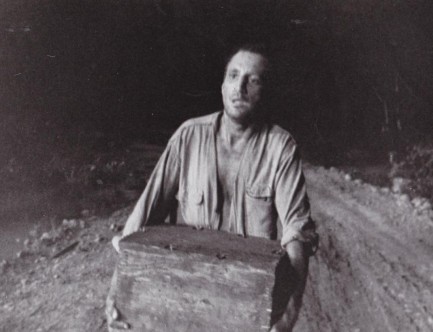 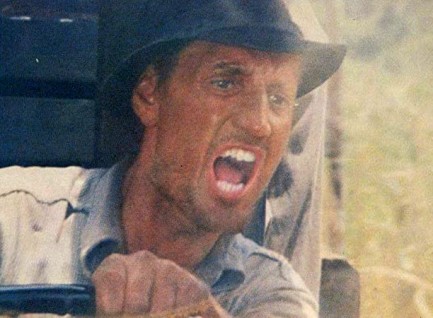 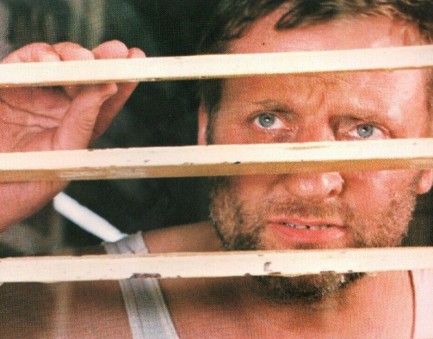 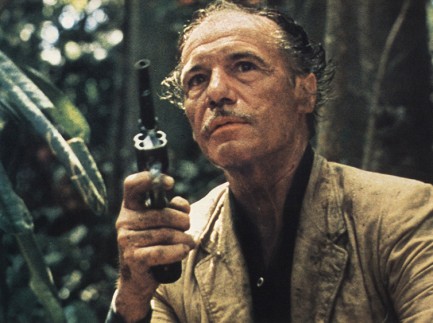 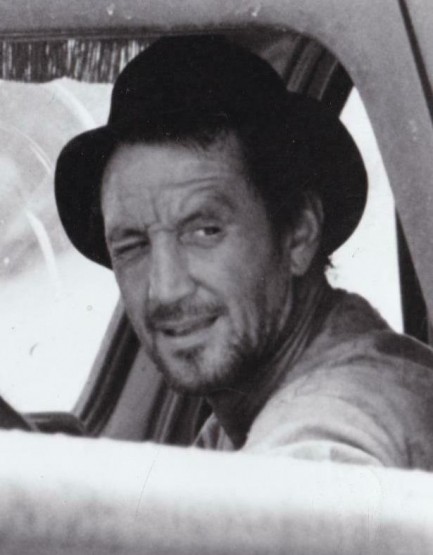 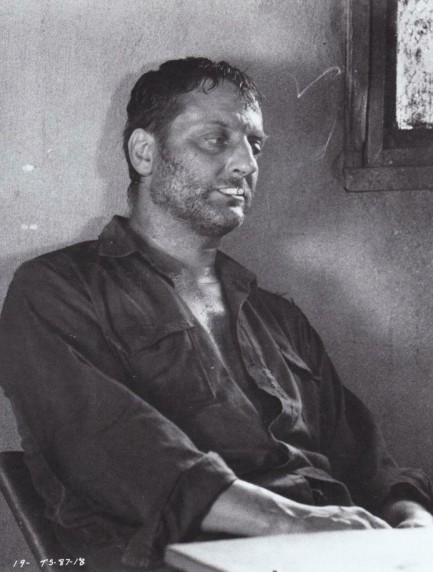 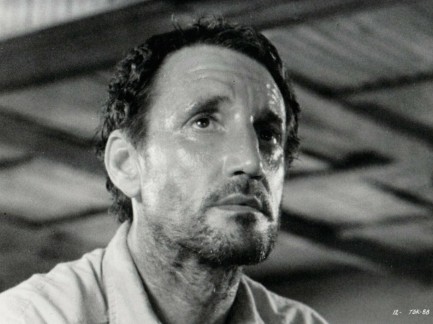 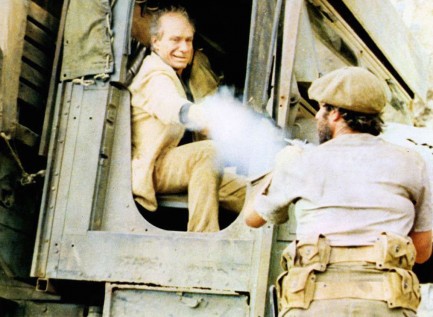 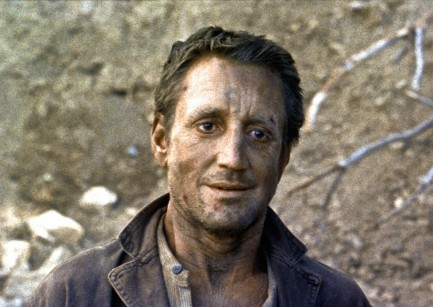
That is not a smile of happiness. That's a smile of insanity. 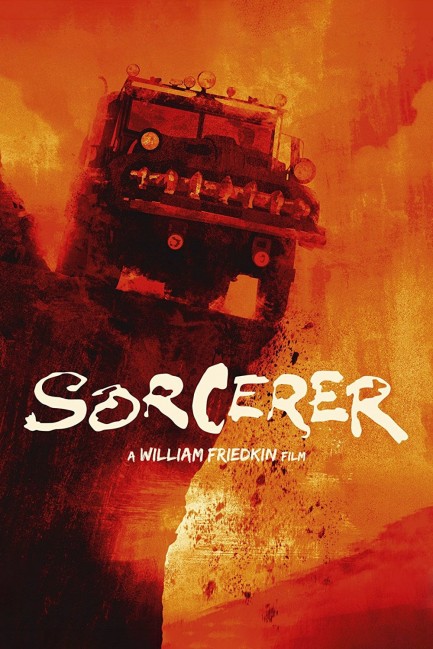
 It could be worse, I guess—I could be working at Wal-Mart. 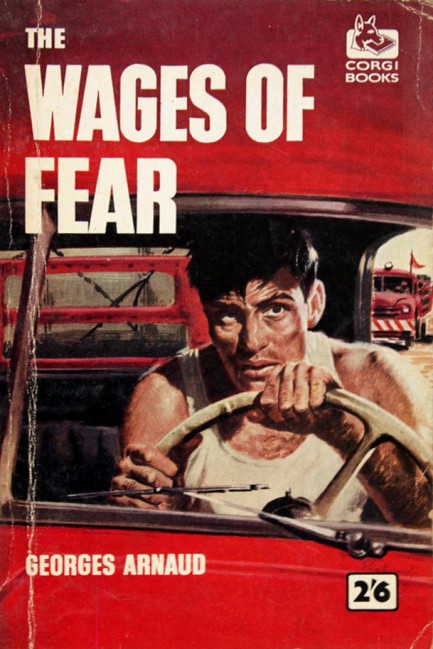
Georges Arnaud’s 1952 thriller Le salaire de la peur, aka The Wages of Fear has one of the great set-ups in literary history—four desperate men agree to drive two truckloads of nitroglycerine through the treacherous Guatemalan mountains to where it’s needed to put out an oil well fire. Mud, rain, potholes, steep inclines, hairpin turns, and fallen boulders are bad enough on their own, but for men strapped into rolling bombs each of these is a deadly test of both luck and nerves. Arnaud’s masterpiece sold more than two million copies worldwide, which is why if you seek out a vintage copy you’ll find many versions, including this Corgi edition from 1960 with uncredited but excellent cover art. This book has always resonated for us because we lived in Guatemala for two years, which made it mandatory reading. But you’ll appreciate it even if you’ve never been there.
 Only the good go to sleep at night. 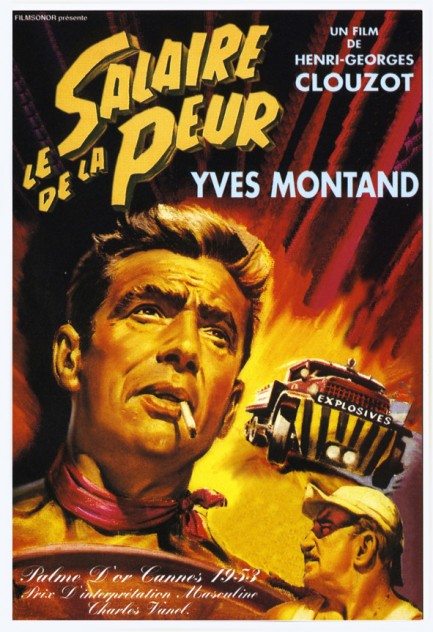
The French coined the term film noir, so it seems only fitting to feature a collection of French posters celebrating the genre. Above and below are fifteen examples promoting films noir from France, Britain, and the U.S., representing some of the best ever produced within the art form, as well as some less celebrated examples that we happen to love. Of those, we highly recommend seeing Le salaire de la peur, for which you see the poster above, and Ride the Pink Horse, below, which played as Et tournent les chevaux de bois in France. Just a word about those films (and feel free to skip ahead to the art, because really, who has time these days to listen to a couple of anonymous internet scribes ramble on about old movies?). 1953’s Le salaire de la peur is about a group of men stranded in an oil company town in the mountains of Latin America. In order to earn the wages to get out, four of them agree to drive two trucks filled with nitroglycerine over many miles of dangerous terrain. The idea is to use the chemicals to put out a raging oil well fire that is consuming company profits by the second, but of course the film is really about whether the men can even get there alive. Le salaire de la peur was critically praised when released in Europe, but in the U.S., political factions raised their ugly heads and got censors to crudely re-edit the prints so as to reduce the movie’s anti-capitalist (and by extension anti-American) subtext. The movie was later remade by Hollywood twice—once in 1958 as Hell’s Highway, and again in 1977 as Sorcerer. The original is by far the best.
1947’s Ride the Pink Horse is an obscure noir, but a quintessential one, in our opinion. If many noirs feature embittered World War II vets as their anti-heroes, Robert Montgomery’s Lucky Gagin is the bitterest of them all. He arrives in a New Mexico border town on a quest to avenge the death of a friend. The plot is thin—or perhaps stripped down would be a better description—but Montgomery’s atmospheric direction makes up for that. Like a lot of mid-century films featuring ethnic characters, the most important one is played by a white actor (Wanda Hendrix, in a coating of what looks like brown shoe polish). It's racist, for sure, but within the universe of the film Lucky Gagin sees everyone around him only as obstacles or allies—i.e., equals within his own distinct worldview. So that makes up for it. Or maybe not. In any case, we think Ride the Pink Horse is worth a look. Thirteen more posters below.
|
 |

The headlines that mattered yesteryear.
2003—Hope Dies
Film legend Bob Hope dies of pneumonia two months after celebrating his 100th birthday. 1945—Churchill Given the Sack
In spite of admiring Winston Churchill as a great wartime leader, Britons elect
Clement Attlee the nation's new prime minister in a sweeping victory for the Labour Party over the Conservatives. 1952—Evita Peron Dies
Eva Duarte de Peron, aka Evita, wife of the president of the Argentine Republic, dies from cancer at age 33. Evita had brought the working classes into a position of political power never witnessed before, but was hated by the nation's powerful military class. She is lain to rest in Milan, Italy in a secret grave under a nun's name, but is eventually returned to Argentina for reburial beside her husband in 1974. 1943—Mussolini Calls It Quits
Italian dictator Benito Mussolini steps down as head of the armed forces and the government. It soon becomes clear that Il Duce did not relinquish power voluntarily, but was forced to resign after former Fascist colleagues turned against him. He is later installed by Germany as leader of the Italian Social Republic in the north of the country, but is killed by partisans in 1945.
|

|
|

It's easy. We have an uploader that makes it a snap. Use it to submit your art, text, header, and subhead. Your post can be funny, serious, or anything in between, as long as it's vintage pulp. You'll get a byline and experience the fleeting pride of free authorship. We'll edit your post for typos, but the rest is up to you. Click here to give us your best shot.

|
|


 critique about how the impoverished will take deadly chances for a little cash, and how corporations take advantage of that desperation without concern or empathy, particularly when the balance sheet slips into the red. The backstory of the oil company is important to the narrative.
critique about how the impoverished will take deadly chances for a little cash, and how corporations take advantage of that desperation without concern or empathy, particularly when the balance sheet slips into the red. The backstory of the oil company is important to the narrative.














